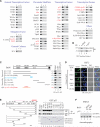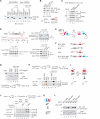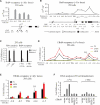Phospho switch triggers Brd4 chromatin binding and activator recruitment for gene-specific targeting
- PMID: 23317504
- PMCID: PMC3595396
- DOI: 10.1016/j.molcel.2012.12.006
Phospho switch triggers Brd4 chromatin binding and activator recruitment for gene-specific targeting
Abstract
Bromodomain-containing protein 4 (Brd4) is an epigenetic reader and transcriptional regulator recently identified as a cancer therapeutic target for acute myeloid leukemia, multiple myeloma, and Burkitt's lymphoma. Although chromatin targeting is a crucial function of Brd4, there is little understanding of how bromodomains that bind acetylated histones are regulated, nor how the gene-specific activity of Brd4 is determined. Via interaction screen and domain mapping, we identified p53 as a functional partner of Brd4. Interestingly, Brd4 association with p53 is modulated by casein kinase II (CK2)-mediated phosphorylation of a conserved acidic region in Brd4 that selectively contacts either a juxtaposed bromodomain or an adjacent basic region to dictate the ability of Brd4 binding to chromatin and also the recruitment of p53 to regulated promoters. The unmasking of bromodomains and activator recruitment, concurrently triggered by the CK2 phospho switch, provide an intriguing mechanism for gene-specific targeting by a universal epigenetic reader.
Copyright © 2013 Elsevier Inc. All rights reserved.
Figures







Comment in
-
Anything but simple: a phosphorylation-driven toggle within Brd4 triggers gene-specific transcriptional activation.Mol Cell. 2013 Mar 7;49(5):838-9. doi: 10.1016/j.molcel.2013.02.021. Mol Cell. 2013. PMID: 23473602 Free PMC article.
Similar articles
-
RNAs interact with BRD4 to promote enhanced chromatin engagement and transcription activation.Nat Struct Mol Biol. 2018 Aug;25(8):687-697. doi: 10.1038/s41594-018-0102-0. Epub 2018 Aug 3. Nat Struct Mol Biol. 2018. PMID: 30076409 Free PMC article.
-
Phosphorylation-dependent BRD4 dimerization and implications for therapeutic inhibition of BET family proteins.Commun Biol. 2021 Nov 9;4(1):1273. doi: 10.1038/s42003-021-02750-6. Commun Biol. 2021. PMID: 34754068 Free PMC article.
-
The double bromodomain-containing chromatin adaptor Brd4 and transcriptional regulation.J Biol Chem. 2007 May 4;282(18):13141-5. doi: 10.1074/jbc.R700001200. Epub 2007 Feb 28. J Biol Chem. 2007. PMID: 17329240 Review.
-
Histone cross-talk connects protein phosphatase 1α (PP1α) and histone deacetylase (HDAC) pathways to regulate the functional transition of bromodomain-containing 4 (BRD4) for inducible gene expression.J Biol Chem. 2014 Aug 15;289(33):23154-23167. doi: 10.1074/jbc.M114.570812. Epub 2014 Jun 17. J Biol Chem. 2014. PMID: 24939842 Free PMC article.
-
Involvement of Brd4 in different steps of the papillomavirus life cycle.Virus Res. 2017 Mar 2;231:76-82. doi: 10.1016/j.virusres.2016.12.006. Epub 2016 Dec 10. Virus Res. 2017. PMID: 27965149 Free PMC article. Review.
Cited by
-
The complex nature of lncRNA-mediated chromatin dynamics in multiple myeloma.Front Oncol. 2023 Dec 11;13:1303677. doi: 10.3389/fonc.2023.1303677. eCollection 2023. Front Oncol. 2023. PMID: 38148842 Free PMC article. Review.
-
Erythropoiesis provides a BRD's eye view of BET protein function.Drug Discov Today Technol. 2016 Mar;19:23-28. doi: 10.1016/j.ddtec.2016.05.004. Epub 2016 Jul 20. Drug Discov Today Technol. 2016. PMID: 27769353 Free PMC article. Review.
-
Molecular interactions of miR-338 during tumor progression and metastasis.Cell Mol Biol Lett. 2021 Apr 7;26(1):13. doi: 10.1186/s11658-021-00257-w. Cell Mol Biol Lett. 2021. PMID: 33827418 Free PMC article. Review.
-
Signal-Dependent Recruitment of BRD4 to Cardiomyocyte Super-Enhancers Is Suppressed by a MicroRNA.Cell Rep. 2016 Aug 2;16(5):1366-1378. doi: 10.1016/j.celrep.2016.06.074. Epub 2016 Jul 14. Cell Rep. 2016. PMID: 27425608 Free PMC article.
-
Loss of BRD4 induces cell senescence in HSC/HPCs by deregulating histone H3 clipping.EMBO Rep. 2023 Oct 9;24(10):e57032. doi: 10.15252/embr.202357032. Epub 2023 Aug 31. EMBO Rep. 2023. PMID: 37650863 Free PMC article.
References
-
- Alsarraj J, Walker RC, Webster JD, Geiger TR, Crawford NP, Simpson RM, Ozato K, Hunter KW. Deletion of the proline-rich region of the murine metastasis susceptibility gene Brd4 promotes epithelial-to-mesenchymal transition- and stem cell-like conversion. Cancer Res. 2011;71:3121–3131. - PMC - PubMed
-
- Claudio PP, Cui J, Ghafouri M, Mariano C, White MK, Safak M, Sheffield JB, Giordano A, Khalili K, Amini S, Sawaya BE. Cdk9 phosphorylates p53 on serine 392 independently of CKII. J. Cell. Physiol. 2006;208:602–612. - PubMed
-
- Dawson MA, Prinjha RK, Dittman A, Giotopoulos G, Bantscheff M, Chan WI, Robson SC, Chung CW, Hopf C, Savitski MM, Huthmacher C, Gudgin E, Lugo D, Beinke S, Chapman TD, Roberts EJ, Soden PE, Auger KR, Mirguet O, Doehner K, Delwel R, Burnett AK, Jeffrey P, Drewes G, Lee K, Huntly BJ, Kouzarides T. Inhibition of BET recruitment to chromatin as an effective treatment for MLL-fusion leukaemia. Nature. 2011;478:529–533. - PMC - PubMed
-
- Delmore JE, Issa GC, Lemieux ME, Rahl PB, Shi J, Jacobs HM, Kastritis E, Gilpatrick T, Paranal RM, Qi J, Chesi M, Schinzel AC, McKeown MR, Heffernan TP, Vakoc CR, Bergsagel PL, Ghobrial IM, Richardson PG, Young RA, Hahn WC, Anderson KC, Kung AL, Bradner JE, Mitsiades CS. BET bromodomain inhibition as a therapeutic strategy to target c-Myc. Cell. 2011;146:904–917. - PMC - PubMed
Publication types
MeSH terms
Substances
Grants and funding
LinkOut - more resources
Full Text Sources
Other Literature Sources
Molecular Biology Databases
Research Materials
Miscellaneous

